ASUS G73SW + SNB: Third Time’s the Charm?
by Jarred Walton on March 4, 2011 12:00 AM ESTGood for Gaming, but Can’t Touch the GTX 485M
As for gaming performance, this is the real purpose of the G73 series, and here the Sandy Bridge only offers moderate increases in most titles. This is why either the 470M or even the 485M as an option in the G73SW would have been good, although that would bump the price up even higher. MSI’s GT680R also includes a “Turbo” feature, only this time instead of overclocking the CPU (as in the previous generation GX640), it overclocks the GTX 460M slightly. GPU memory speed is unaffected, so the benefit ranges from negligible to potentially 5% thanks to the GPU overclock (708MHz instead of the stock 675MHz). In practice, there’s a bit more variance than that, but it’s typically just the margin of error for gaming benchmarks.
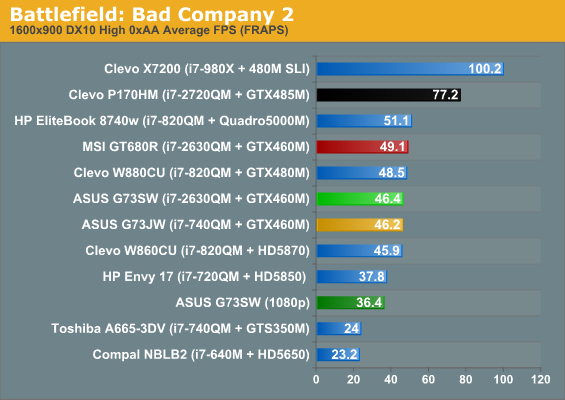
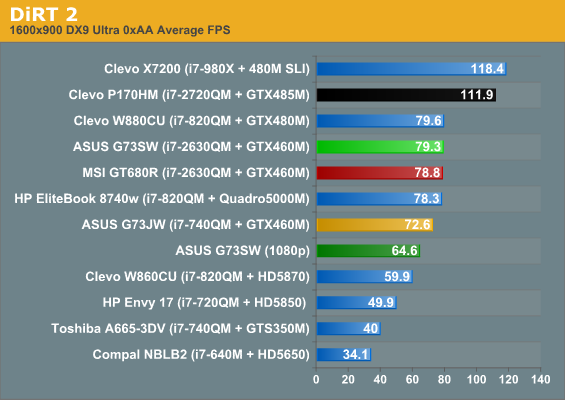
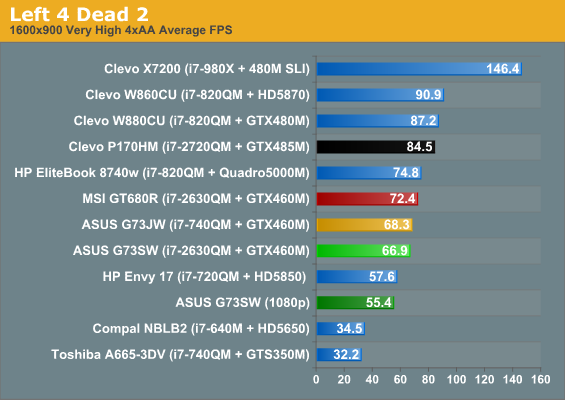
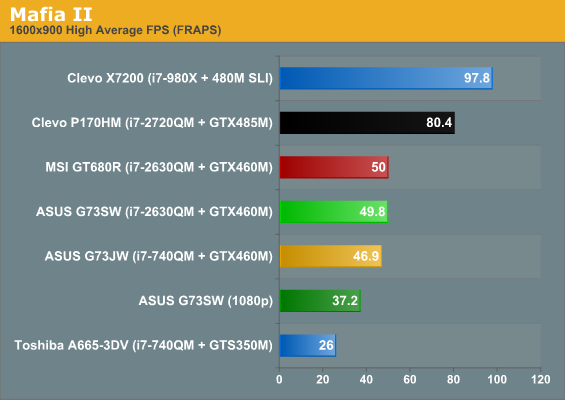
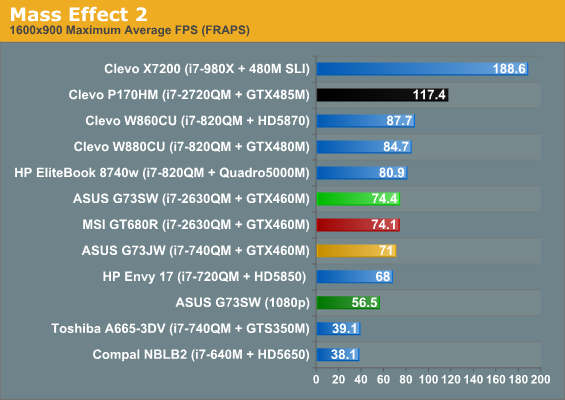
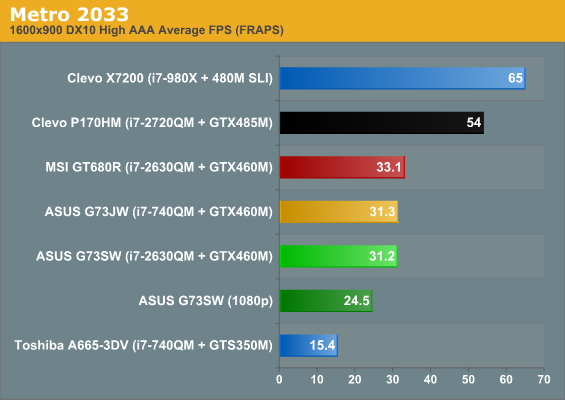
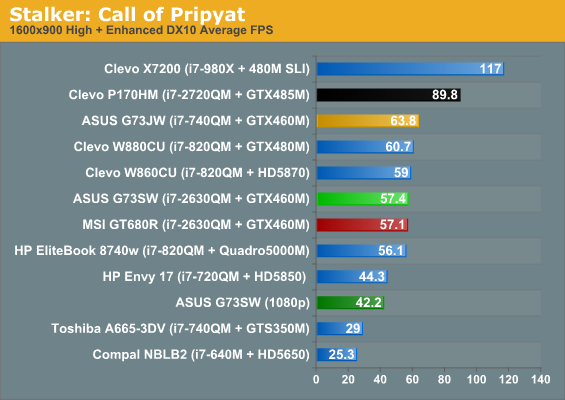
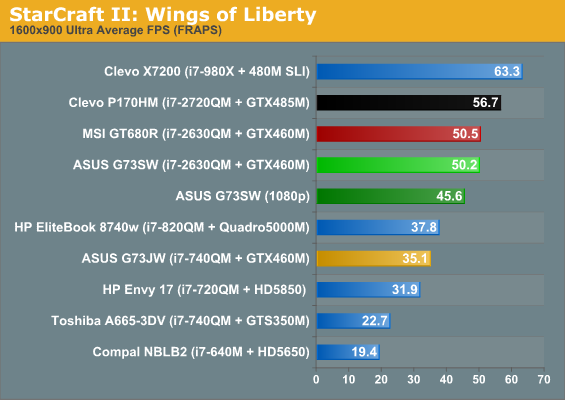
Starting with our High Detail benchmarking, the first thing to note is that all games are playable (i.e. above 30FPS), and even at the LCD’s native 1080p all games remain so, with the exception of Metro 2033. That happens to be a punishing title on even the fastest of GPUs, so we wouldn’t worry too much about the lower score. Also worth noting is that for some reason, both the G73SW and the MSI GT680R scored exceptionally high on the STALKER benchmark; there’s apparently something wrong with our test resolution of 1600x900, as 1600x1024 and 1366x768 both ran much slower. We’ve chosen to scale the 1600x1024 result by 13.8% (i.e. 1024 is 13.8% more than 900) as the 900p score of 114.6 is clearly wrong—we’re just not sure why the test runs so much faster than other resolutions. This appears to be a bug in the 266.58 NVIDIA driver, as performance with older drivers was as expected.
As far as comparisons go, the G73SW ends up being anywhere from 10% slower to 10% faster than the older G73JW. In theory, it should never be slower, but driver changes likely account for the discrepancies. The performance in BFBC2, L4D2, and Metro 2033 remains unchanged (i.e. the new CPU doesn’t change the performance at all); DiRT 2 and Mafia II are 6% and 9% faster, respectively; finally, StarCraft II is the poster child for Sandy Bridge, as performance is up a healthy 43%. Moving over to the MSI GT680R comparison, as expected the differences are generally negligible. BFBC2 and Metro 2033 are 6% faster and L4D2 is 8% faster, while the remaining five titles are within 1% of each other. And then there’s the P170HM with GTX 485M, which is anywhere from 13% (StarCraft II) to 73% (Metro 2033) faster than the G73SW. Actually, only L4D2 and SC2 are under 25%; the other six titles show an improvement of at least 41%.
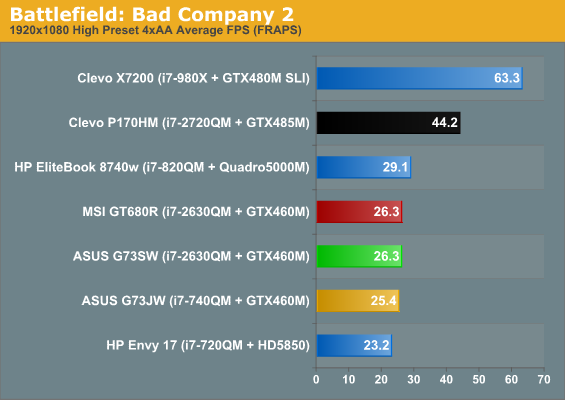
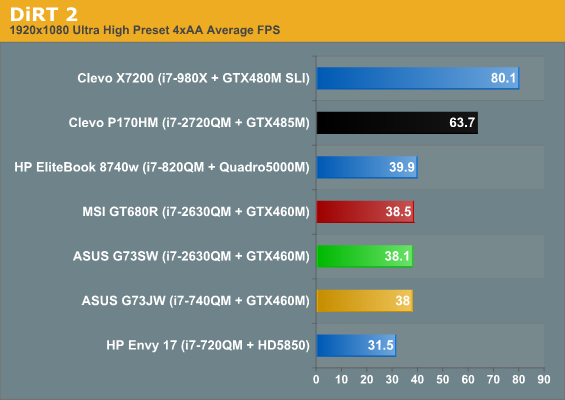
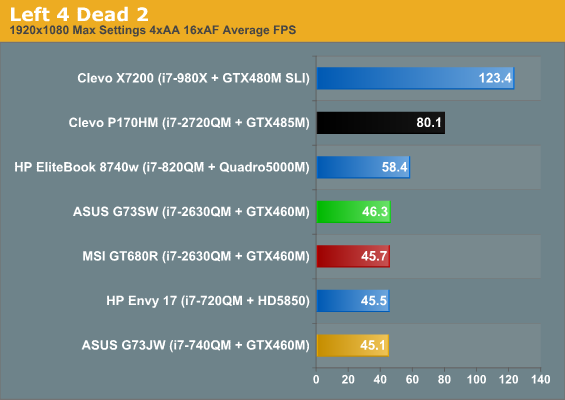

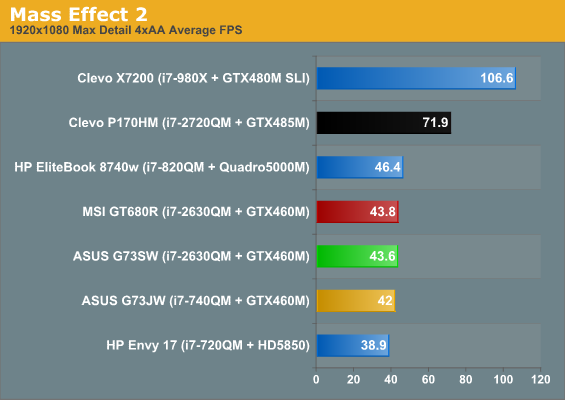
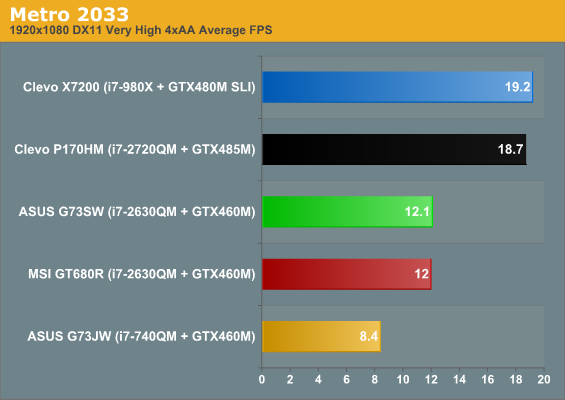
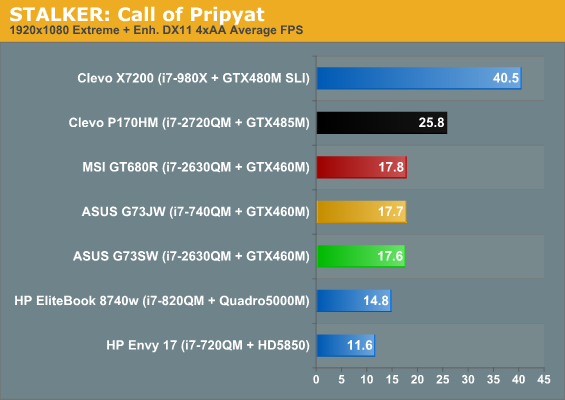

Bumping up to our Ultra settings tends to be too much for most of the single-GPU mobile solutions. DiRT 2, L4D2, and Mass Effect 2 still break 30FPS, but everything else is in the 20s or even teens. One of the major issues with most mobile GPUs is that they simply don’t have the memory bandwidth to handle high detail settings with 4xAA, but then there are titles like Metro 2033 and STALKER where enabling DX11 features and SSAO just kills performance. Even the mighty 485M and 480M SLI fail to break 20FPS in Metro 2033 at our Ultra settings.
Looking at comparisons once more, this time the G73JW and G73SW are nearly tied (-1% to 4% lead for the SW), with the exception of Metro where the SW is 44% “faster”. Of course, 12.1FPS versus 8.4FPS is hardly a meaningful comparison, as neither option is remotely playable. The slight overclock of the GT680R GPU also fails to help here, as the memory bandwidth requirements overshadow the 5% core clock increase, resulting in scores that are all within 1%. Finally, the GTX 485M is able to post comfortable leads across the test suite. The closest the G73SW can get is in STALKER, where the 485M is 47% faster; in the remaining titles the lead is at least 55% and as much as 73%.
When you consider the total cost of a gaming notebook, the extra $500 to upgrade the P170HM to a GTX 485M actually starts to make sense—who'd have thought? But what about the HD 6970M from AMD? If you don’t mind a little spoiler.... <spoiler>I can tell you that out of the eight titles we test, the GTX 485M leads in five games and the 6970M takes the other three; most of the margins are single-digit percentages, but a few break into double-digits. It looks like NVIDIA will maintain their overall lead in mobile GPU performance, but only by a small amount; the question now is how the two GPUs compare in terms of power, heat, pricing, and availability. We’ll get into that more with our review of the Clevo P150HM next week… </spoiler>










56 Comments
View All Comments
Frallan - Friday, March 4, 2011 - link
I bought an old ASUS gaming lappy with turbo and the 6800GT in it it has served for a long time now and has been demoted to girlfriend computer now. So Im in the market for a new gaming lappy. BUT when spending that much money I want to have decent performance.Therefore I will wait until there is a good sandy brige / GPU combo is out there. Id like it to come from ASUS bc of the good experience Ive had with the old Lappy but if this is what they will have then they\re out of the game.
BR
/F
jcandle - Friday, March 4, 2011 - link
"Contenders like the MSI GT680R (going for $1475 online) offer nearly identical specs"Hey Jarred, how is that a contender? The MSI is a 15 and the Asus is a 17. I have no idea why but bigger in gaming notebooks generally translates to more expensive. Perhaps manufacturers are betting gamers place value on tonnage.
JarredWalton - Friday, March 4, 2011 - link
It's a gaming notebook, therefore it's a contender. The ASUS G53SW is also in the rink, along with Clevo P150HM and P170HM. I'm also a bit surprised that there are essentially equivalent spec notebooks that are smaller and cost less; that's usually not the case. Perhaps the high contrast HannStar LCD is adding more to the total than I think?jcandle - Friday, March 4, 2011 - link
That's exactly my point. Its not an apples to apples comparison because Asus does have the G53SW that essentially the same machine with 1 less HDD with a much lower price point resolving the pricing issue you were so lamenting. You can't compare a 17" machine and says its more expensive than a 15" when similar offering from companies like Dell with Alienware are doing exactly the same thing.JarredWalton - Friday, March 4, 2011 - link
The MSI still supports two HDDs, though, which means the only difference is the overall design elements and the LCD size. The LCD should be a wash, really (both are 1080p, so maybe $25-$50 difference at most). ASUS has the keyboard backlighting and better thermals. Do those three items add up to a nearly $300 price difference? I don't think so.If you go with the ASUS G53SW-XR1 and compare that to the MSI, you still have to factor in the single HDD. I'm also a bit concerned that ASUS might be selling some B2 stepping chipsets with a single HDD, but I don't know for sure if that's the case. Will the Cougar Point bug affect the DVDR or eSATA down the line, or if you add a second HDD/SSD will that be a problem? Hopefully I'm wrong and they're not selling any B2 chipsets in the G53/73 chassis.
Anyway, I've edited the text slightly to clarify that I'm looking at all similar performance gaming notebooks, not necessarily just "all 17.3-inch heavyweight contenders". :-)
jcandle - Friday, March 4, 2011 - link
Don't get me wrong I'm backing you up on the point that "essentially equivalent spec notebooks that are smaller and cost less" Maybe there should be some investigating to find out why manufacturers are simply bumping up the form factor and asking for a non-proportional $300 price difference.mattwco - Saturday, March 5, 2011 - link
When stock levels come back, there's an -XR1 variant that has one HDD and a DVD-RW for $1400. It may have a lesser warranty as well.If you're comparing the G73SW to other laptops, please note that there's more than one G73SW. BTW, the 3D version is also coming back in stock at ~$1900.
mattwco - Saturday, March 5, 2011 - link
Jarred mentioned the XR1 version above. Several other variants are available at different price points. The -B3 has a better warranty than the -A1.Example, not company recommendation:
http://pro-star.com/index.cfm?mainpage=product&...
Also, the laptops with the fixed chipset are explicitly labeled so on the laptop and on the box.
http://www.asus.com/News.aspx?N_ID=Bdmf9rXuqU29SRs...
piroroadkill - Friday, March 4, 2011 - link
8GB is thoroughly pointless, as is a quad core.I'd much rather have a higher clocked dual core for gaming... 4GB RAM is just fine..
... and mechanical disks? One SSD, one Mechanical disk is the correct way.
piroroadkill - Friday, March 4, 2011 - link
I should note, on my dual/quad comment, I meant that a higher clocked dual core would be a better tradeoff for performance/power use in the vast majority of games. Obviously a high clocked quad is the best of all worlds.